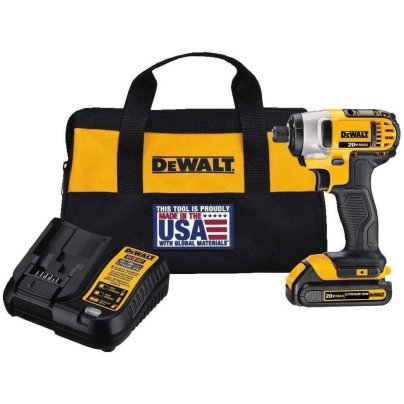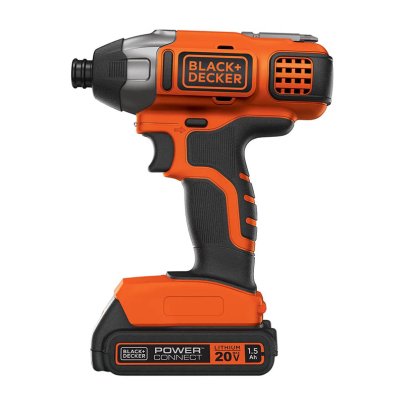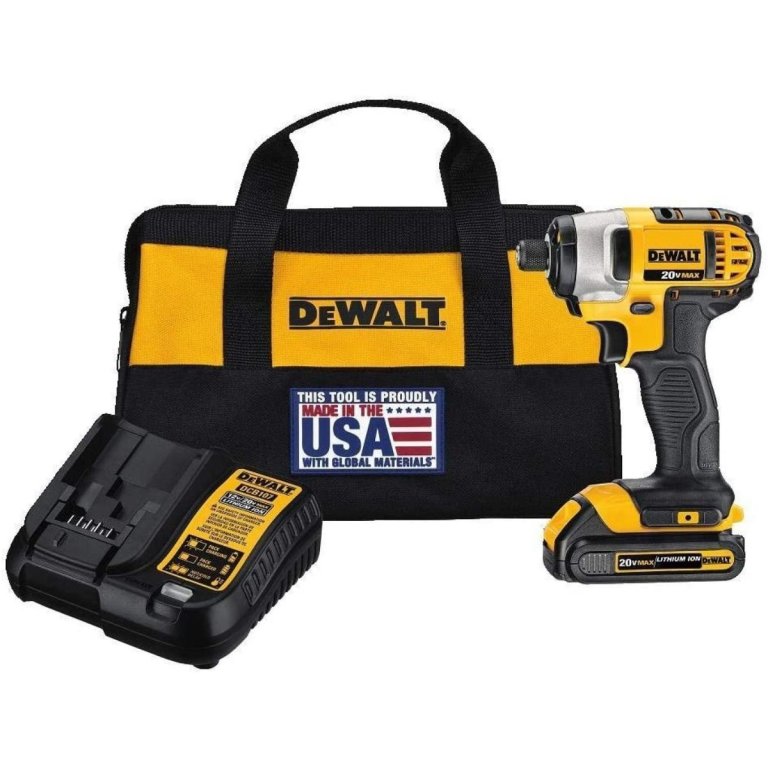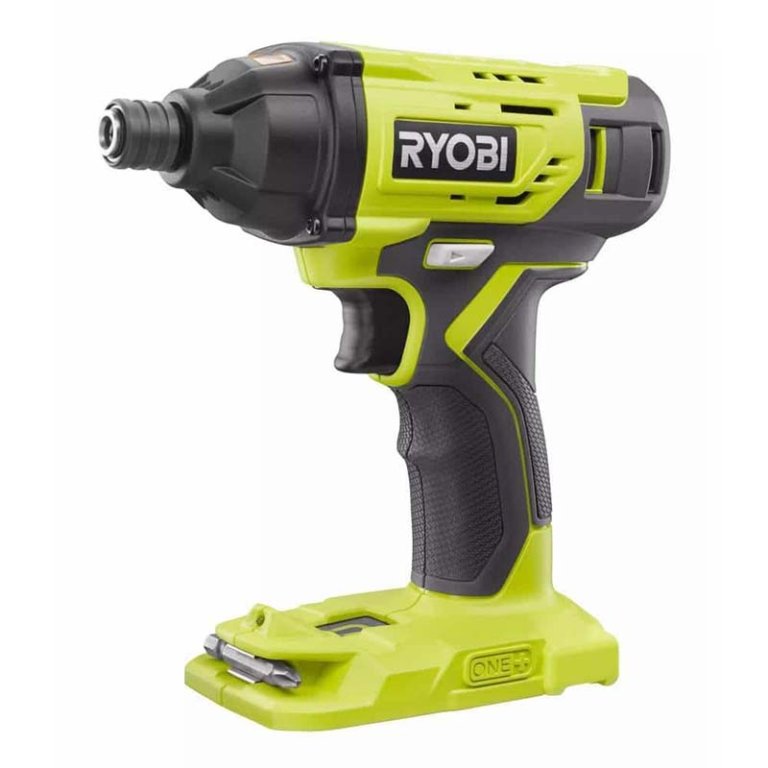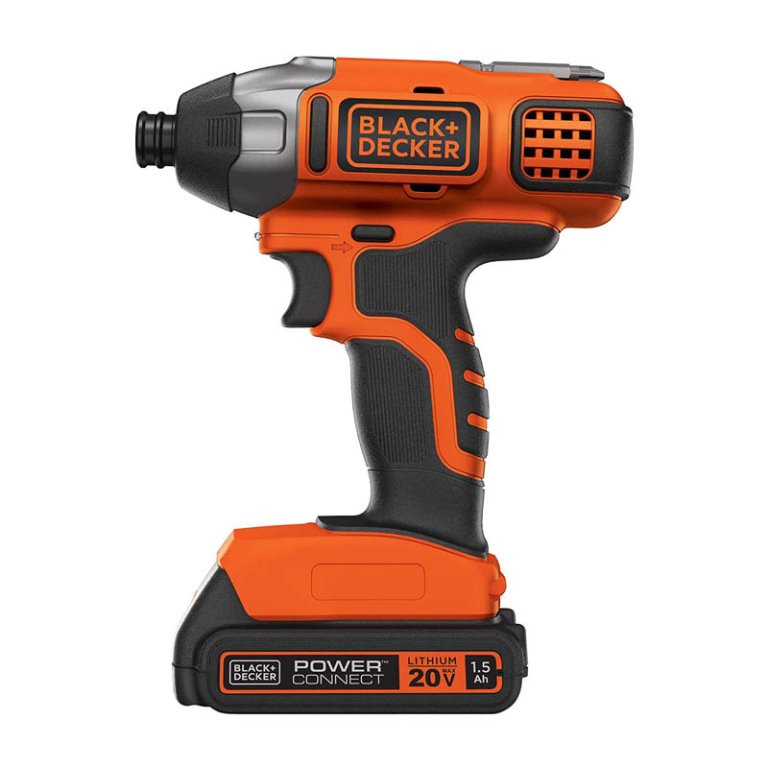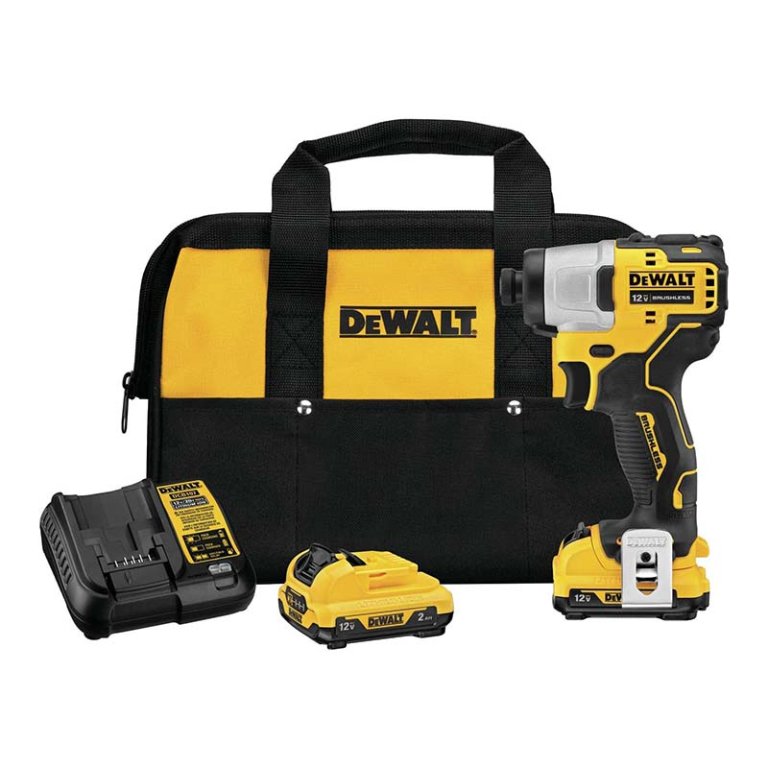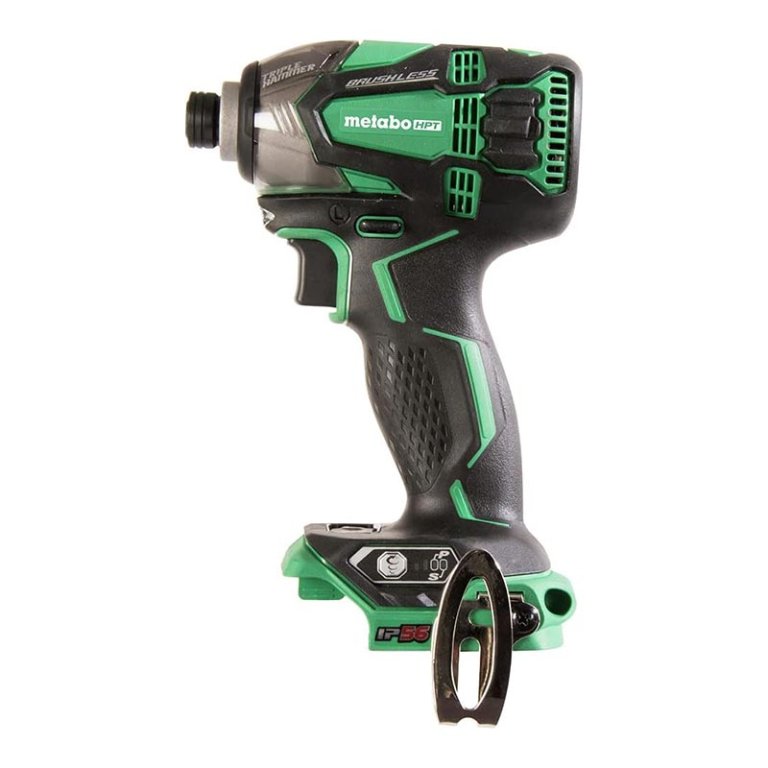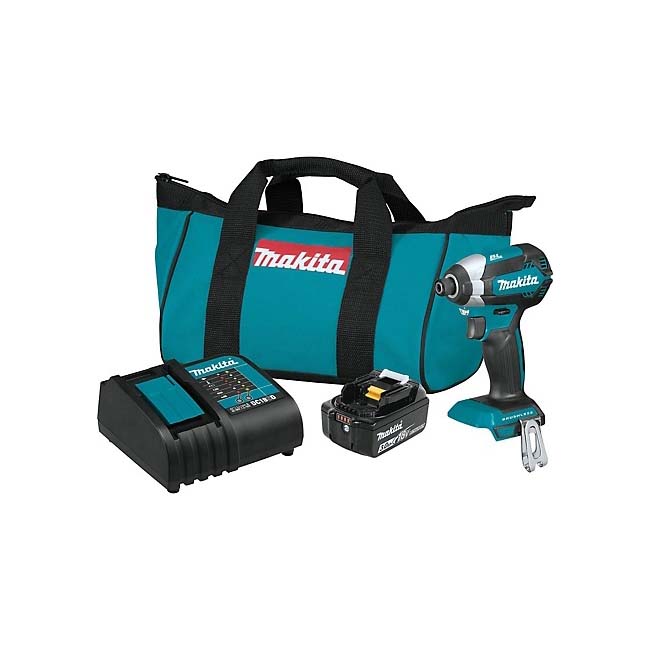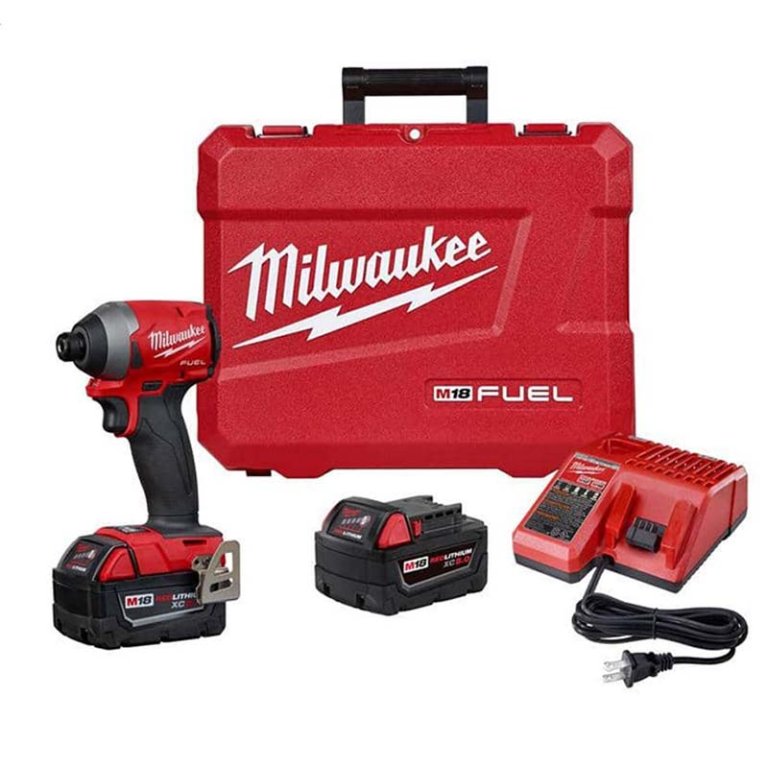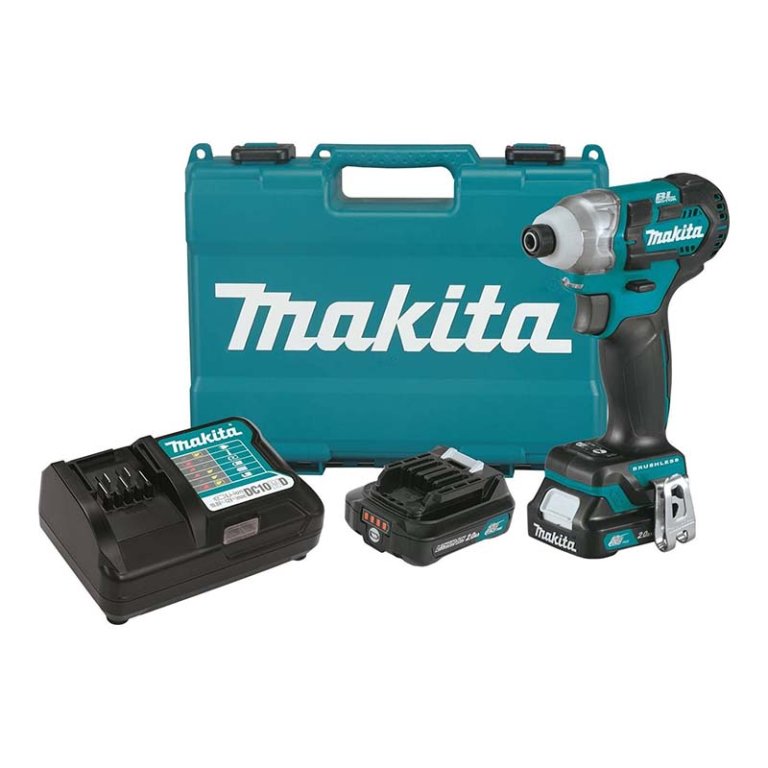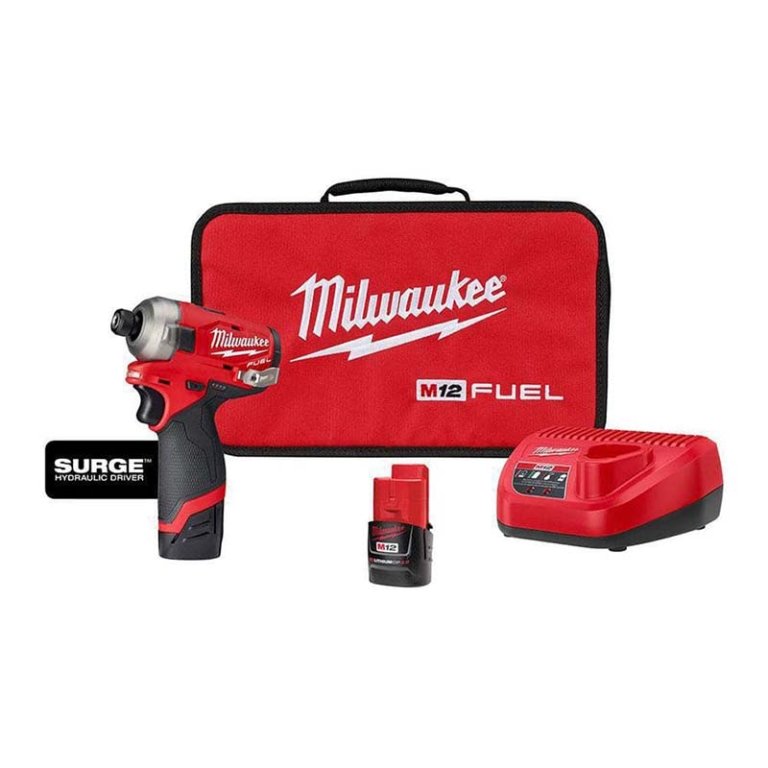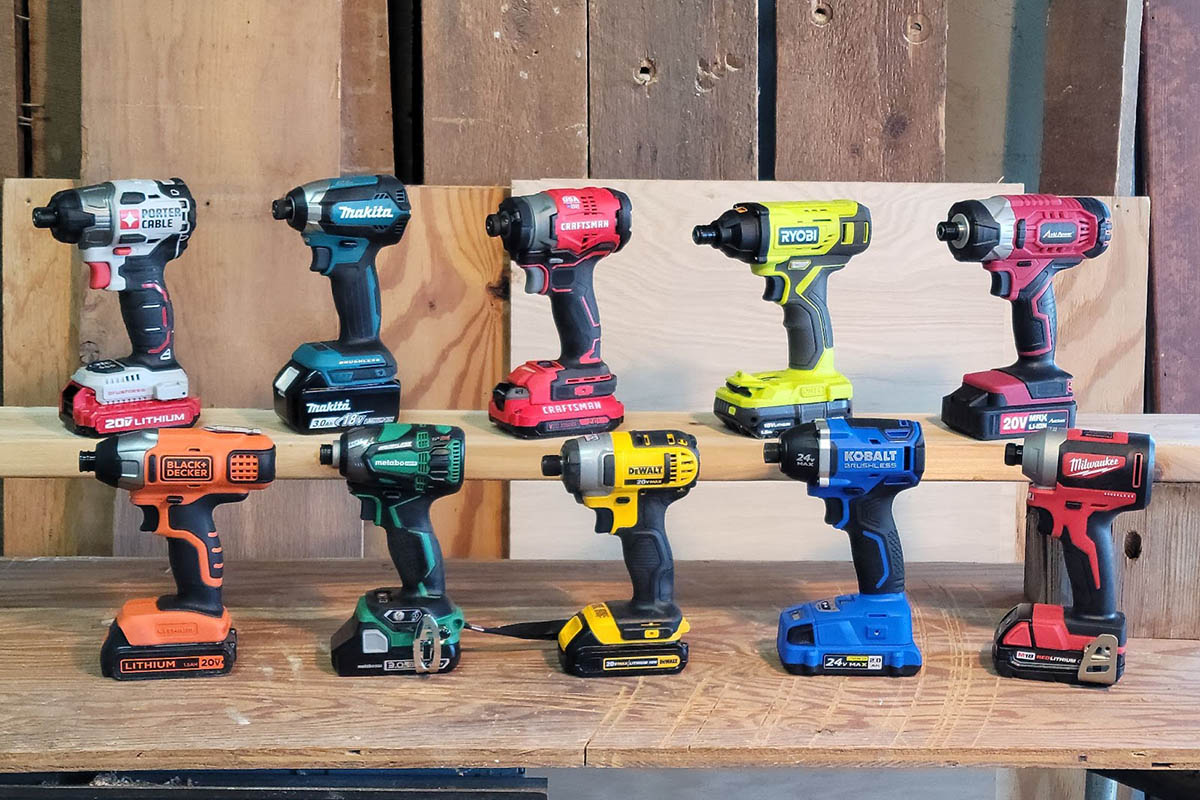
We may earn revenue from the products available on this page and participate in affiliate programs. Learn More ›
If you’re ready to tackle challenging jobs involving larger or longer screws and fixings, look no further than the mighty impact driver, a must-have addition to any DIYer’s tool collection. Built specifically for heavy-duty screwdriving tasks that would leave an ordinary drill/driver struggling, an impact driver is the ticket to effortless decking, framing a house, or loosening stubborn screws.
In today’s market, the choices for impact drivers have multiplied. To help you make the right choice, I tested the most popular sellers and pushed them to their limits. We also spoke to Brayden Montgomery, owner of Vantage Builders, a home remodeling and construction company in West Haven, Utah, and got his expert advice. In testing, my favorite model was DeWalt’s 20V MAX ¼-inch impact driver due to its excellent performance, sensitive variable-speed trigger, and impressive torque and power. Impact drivers like this one should pack enough power to handle the types of projects you plan to tackle. Read on to learn how the best impact drivers differ from regular drills and which ones performed the best (and the worst) in my hands-on tests.
- BEST OVERALL: DeWalt DCF885C1 20V MAX ¼-Inch Impact Driver Kit
↓ Jump to Review - BEST BANG FOR THE BUCK: Ryobi 18V ONE+ Cordless ¼-Inch Impact Driver
↓ Jump to Review - BEST ALL-PURPOSE: Black+Decker 20V MAX Powerconnect Impact Driver Kit
↓ Jump to Review - BEST FOR DIYERS: DeWalt DCF801F2 Xtreme 12V MAX Impact Driver Kit
↓ Jump to Review - BEST TORQUE: Metabo HPT 18V Triple-Hammer Impact Driver
↓ Jump to Review - BEST SPEED SELECTION: Makita XDT16Z 18V Quick-Shift 4-Speed Impact Driver
↓ Jump to Review - BEST COMPACT: Milwaukee 2853-22 M18 Fuel Hex Impact Driver Kit
↓ Jump to Review - BEST LIGHT-DUTY: Makita DT04R1 12V MAX CXT Brushless Impact Driver Kit
↓ Jump to Review - LONGEST RUNTIME: Kobalt 24V MAX Variable-Speed Brushless Impact Driver
↓ Jump to Review - ALSO CONSIDER: Milwaukee 2551-22 M12 Fuel Surge Hydraulic Driver Kit
↓ Jump to Review
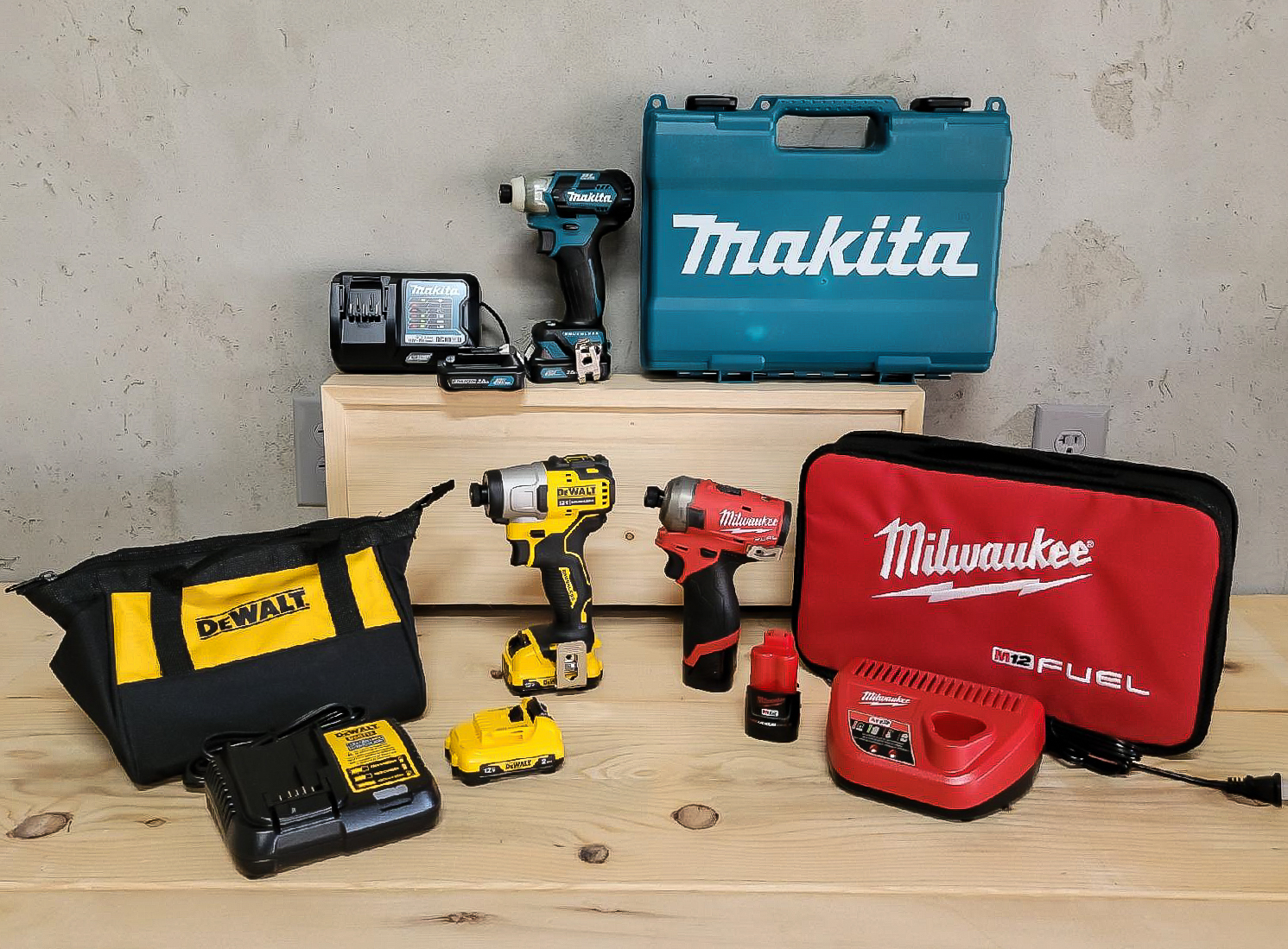
Before You Buy an Impact Driver
Impact drivers and drills look similar at a glance. In fact, manufacturers often bundle them together in a single package. But both have their purpose, and not everyone needs impact tools. If you don’t tackle many major DIY projects around the house, you may not need the extra oomph of an impact driver. Additionally, if you’re on a budget, you may be able to get by with a quality drill/driver.
- A drill/driver (or simply a drill) drills pilot holes and fastens screws in a wide variety of materials. DIYers can use them to hang shelves, assemble furniture, and fit all manner of hinges and brackets. They accept bits from as small as 3/64 inch to over 1 inch, depending on the power of the drill and the type of bit.
- An impact driver is a handy little dynamo designed to do one thing: drive various types of fasteners. As a drill, it uses rotational force to drive screws into wood, for example. But, unlike the smooth rotation of a drill, an impact driver uses rotational hammering, which is more effective at driving fixings with screw threads. DIYers often use them for long decking screws, lag bolts, and similar fixings.
Montgomery says that impact drivers specifically excel at driving lag bolts, deck screws, and threaded rod into dense materials like concrete, steel, and treated wood. “The hammering action prevents cam out and slipping,” he says. “I used an impact to drive 6-inch timber screws into glulam beams for a timber frame house. Regular drills would have struggled.”
Unlike drills, impact drivers do not have a three-jaw self-centering chuck. Instead, they have a quick-release hexagonal chuck that accepts bits with a hexagonal shank. Some impact drivers use a ⅜-inch fitting, but ¼-inch fittings are much more common.

Our Top Picks
The following models met our high-performance testing standards and earned a spot in our lineup of the best impact drivers. Each tool was pushed to its limits to determine how well it would hold up in real-world building situations. While the following impact drivers are better suited for some uses than others, each is a standout in its category for your next go-to tool. Check out both the pros and cons before buying to find the right tool for you.
Best Overall
DeWalt DCF885C1 20V MAX ¼-Inch Impact Driver Kit
See ItWhat We Like
- High torque despite its light weight
- Carrying case, charger, and battery included
- 3 built-in LED lights and an ergonomic grip
What We Don’t Like
- Limited runtime based on low-capacity 1.5-amp-hour battery
Product Specs
- Maximum torque: 1,400 inch-pounds (in-lbs)
- Maximum revolutions per minute (RPM): 2,800
- Weight: 2.8 pounds
Those looking for enough driving power to build a garage or a shed need look no further than the DeWalt 20V MAX impact driver. Aimed at both professionals and enthusiastic DIYers, the tool’s powerful torque at 1,400 in-lbs, compact design, and light weight of just 2.8 pounds make it among the top options for an impact driver. Additionally, this cordless impact driver includes an ergonomic grip that offers good control and three LED lights to brighten dark corners.
As a longtime fan of DeWalt tools, I expected good things from this 20-volt impact driver—and I wasn’t disappointed. It features a one-handed hex chuck to easily switch between bits, and it comes with a 20-volt lithium-ion battery and charger. The 1.5 amp-hour battery was a slight downside, which did not last as long as I felt it should have. I got just over 40 minutes out of the battery at near-constant use. Still, the DeWalt impact driver excelled in inserting various fasteners into softwoods and hardwoods. I found it also worked well for loosening previously frozen fasteners without stripping out the heads.
This is not a brushless driver, which means runtime is slightly shortened, but it’s well engineered and offers considerable torque and power. I was also greatly impressed by the sensitivity of the variable-speed trigger. Consider keeping a spare battery charged to double runtime for the best results.
Get the DeWalt 20-volt impact driver at Amazon or The Home Depot.
Best Bang for the Buck
Ryobi 18V ONE+ Cordless ¼-Inch Impact Driver
See ItWhat We Like
- Drives fasteners into both hardwood and softwood
- Compatibility with Ryobi batteries
- Sturdy cast-aluminum gear housing
What We Don’t Like
- Tool-only purchase; if you don’t own a battery and charger, you’ll need to buy them separately
Product Specs
- Maximum torque: 1,800 in-lbs
- Maximum RPM: 2,800
- Weight: 2.65 pounds
Low-cost tools don’t always perform as well as their more expensive counterparts, but that’s not the case with the 18-volt Ryobi impact driver. It performed on par with some of its more expensive competitors in my testing. It features an impressive 1,800 in-lbs of torque; 3,200 impacts per minute (ipm); and a ¼-inch quick-connect chuck. It also comes with sturdy cast-aluminum gear housing.
Ryobi’s cordless impact driver is a bare tool, but I had a spare 18-volt Ryobi lithium-ion battery that fit perfectly. The lime-green power tool put on an impressive show of driving fasteners into hardwood and softwood and removed overtightened screws without stripping out the heads. At a little over 4 pounds with the battery, I found my arm and hand tiring after using it overhead for a few minutes. Still, it provides enough power to overcome the weight issue, in my opinion—and those with stronger arms might not even notice the slightly heavier weight.
Anyone who doesn’t own another cordless tool from the Ryobi ONE+ system (and already has a battery) will want to purchase a battery and a charger. While this will roughly double the price, it remains a good value at the price point.
Get the Ryobi impact driver at The Home Depot or Amazon.
Best All-Purpose
Black+Decker 20V MAX Powerconnect Impact Driver Kit
See ItWhat We Like
- 1,375 in-lbs of torque and 3,000 RPM of power
- Nonslip padded rubberized grip; ergonomic design
- Balanced weight distribution between the head and battery compartment
What We Don’t Like
- Included 1.5 amp-hour rechargeable battery is relatively low capacity
Product Specs
- Maximum torque: 1,375 in-lbs
- Maximum RPM: 3,000
- Weight: 3.6 pounds
From a company with more than a century-long reputation for producing quality tools comes the Black+Decker 20-volt cordless impact driver. I’m familiar with many of the tools that Black+Decker makes, but I have never used one of their impact drivers. I was pleasantly surprised by the power (1,375 in-lbs of torque) and a high rotation speed of 3,000 RPM. The driver pulls quite a bit of energy from the slightly lackluster 1.5 amp-hour rechargeable battery, so I only got 30 minutes of consistent use out of the driver before I needed to recharge the battery.
I found the Black+Decker impact driver to be very comfortable in hand, and its nonslip rubberized grip added to its ease of use without causing hand fatigue. With the battery in place, the driver is well balanced—with the weight falling almost equally between the head and the battery compartment, which helps stabilize the tool during use.
The power driver excelled at inserting and removing fasteners from softwoods and hardwoods, but the chuck failed to grab the bits securely a couple of times. That may well have been a user error since I was testing at a relatively quick pace and might not have gotten the bits in securely. When I reinserted the bits, I had no problems.
Get the Black+Decker impact driver at Amazon or Lowe’s (tool only).
Best for DIYers
DeWalt DCF801F2 Xtreme 12V MAX Impact Driver Kit
See ItWhat We Like
- Offers more power than many 12-volt impact drivers
- Suitable for a range of tasks
- Designed with excellent balance
- Comfortable grip reduces hand fatigue
- Combines power and portability
What We Don’t Like
- Not as powerful as an 18- or 20-volt tool
Product Specs
- Maximum torque: 1,450 in-lbs
- Maximum RPM: 2,850
- Weight: 1.75 pounds
The DCF801F2 is an impressive cordless DeWalt impact driver that delivers power and versatility in a compact package. I found it to be a standout option in the 12-volt category. Its well-balanced design and comfortable grip made it a pleasure to use, even during extended testing.
One of the noteworthy features of this 12-volt DeWalt is its power. Despite being a lower-voltage model, it easily inserted screws in both softwood and hardwood. This makes it suitable for a wide range of tasks, from everyday household projects to commercial-duty use. For professionals like HVAC technicians who often need to insert or loosen nuts, this impact driver is a great take-along option. It provides enough power to get the job done effectively without the added weight of a larger tool.
In addition to its power, the DCF801F2 is easy to handle and maneuver. It’s particularly well suited for tasks around the house where precision and control are important. Whether you’re working in tight spaces or overhead, this impact driver’s compact and lightweight design ensures that you can easily tackle your projects.
Get the DeWalt Xtreme impact driver at Amazon, Lowe’s, or Acme Tools.
Best Torque
Metabo HPT 18V Triple-Hammer Impact Driver
See ItWhat We Like
- Class-leading torque and triple-hammer technology
- 4-speed adjustment; can insert fasteners effectively in various materials
- Comfortable and lightweight
- Built-in LED light and a charge indicator light
What We Don’t Like
- Comes as a bare tool; must purchase of a compatible 18-volt battery
Product Specs
- Maximum torque: 1,832 in-lbs
- Maximum RPM: 2,900
- Weight: 2.9 pounds
As a fan of the former Hitachi power tool line, I was excited to test the Metabo HPT impact driver. As of 2018, Metabo became the new name for Hitachi tools, and if this impact driver is any indication of the brand’s future, I won’t hesitate to choose more power tools from this line. The Metabo impact driver offers a host of features aimed at the professional, but that shouldn’t put off the serious DIY remodeler. The tool delivers immense power with 1,832 in-lbs of torque and a 4,000 ipm triple-hammer action to drive screws and fasteners home in no time.
With four-stage speed adjustability for maximum precision, the tool reaches speeds up to 2,900 RPM. Weighing 2.9 pounds, it’s very comfortable to handle—neither heavy nor bulky. An LED light and a charge indicator are convenient extras. The Metabo had no problem inserting and removing fasteners in softwoods and hardwoods, and it made quick work of removing frozen/overtightened fasteners without stripping out the heads.
This impact driver comes as a bare tool, so you’ll want to purchase a battery separately. Compatible 18-volt batteries range from a 1.5-amp-hour model (a little underpowered for professional users) to a massive 8-amp-hour model that offers class-leading runtimes. I picked a 3-amp-hour battery, which was more than enough to power the impact driver in my testing. With this much torque, anything less than a 3-amp-hour battery will undercut the performance of this impact driver.
Get the Metabo impact driver at Amazon or Acme Tools.
Best Speed Selection
Makita XDT16Z 18V Quick-Shift 4-Speed Impact Driver
See ItWhat We Like
- Robust, high-quality impact driver; fast and efficient
- 4 speed modes
- Excelled in various tests, including inserting fasteners and removing stuck bolts
What We Don’t Like
- Some retailers only sell it as a bare tool; must purchase a battery and charger separately
Product Specs
- Maximum torque: 1,600 in-lbs
- Maximum RPM: 3,600
- Weight: 2.43 pounds
An impressive tool, the Makita impact driver delivers 1,600 in-lbs of torque. The hammer action runs at 3,800 ipm, and its speed tops out at 3,600 RPM. My favorite feature of the Makita driver is the ability to choose from four different speed modes by pushing a small button just below the chuck. This speed selection is in addition to the tool’s variable-speed trigger, so I was able to regulate the RPM to suit the material and the types of fasteners I was testing.
A brushless motor maximizes battery efficiency, but keep in mind this driver comes as a bare tool from some retailers—users will want to purchase a battery and charger separately. I used a 3-amp-hour lithium-ion battery from another Makita tool I own to test the impact driver. Although my battery was over a year old, I got over an hour of runtime from the Makita driver before I needed to recharge.
In addition to inserting and removing screw fasteners, I tested the Makita impact driver on overtightened bolt removal, and it excelled in all tests.
Get the Makita 18-volt impact driver at Tractor Supply Co. (includes battery) or The Home Depot.
Best Compact
Milwaukee 2853-22 M18 Fuel Hex Impact Driver Kit
See ItWhat We Like
- Compact and lightweight design; an easily portable impact driver
- Nonslip rubberized grip
- Variable-speed trigger
What We Don’t Like
- Materials used in body feel thinner and less robust than some models
Product Specs
- Maximum torque: 2,000 in-lbs
- Maximum RPM: 3,600
- Weight: 2.2 pounds
A remarkably compact tool, the 18-volt brushless Milwaukee M18 impact driver can access fixings in tight spots where larger impact drivers might not be suitable. Its space-saving design features a compact head and grip. Comfortable to hold and easy to manage, the Milwaukee weighs in at just 2.2 pounds and is just 4.59 inches long from the chuck to the back of the tool.
Despite its compact size, I found the Milwaukee M18 impact driver provided nearly as much power as some of the larger models I tested. Maximum torque comes in at a very competitive 2,000 in-lbs—plenty for DIY tasks, remodeling, and light construction work. The compact driver comes with an 18-volt 2-amp-hour battery, which offers nearly an hour of continuous runtime before requiring a recharge. The charger is also included. I was slightly disappointed in the tool’s body quality—the materials didn’t seem on par for the Milwaukee brand. The plastic felt thinner, but it wasn’t cheap by any means.
I found this compact driver well suited to overhead use, as it didn’t tire my arm as quickly as the heavier drivers. Its nonslip rubberized grip also allowed me to grasp the tool firmly, no matter the working angle. The Milwaukee M18 impact driver comes with a smooth variable trigger, which made it easy for me to control the RPM for the material. The tool didn’t lose power or slow down when inserting fasteners in hardwood, and its enviable 4,300-ipm hammer action knocked loose frozen screws without a hitch.
Get the Milwaukee M18 impact driver at Amazon.
Best Light-Duty
Makita DT04R1 12V MAX CXT Brushless Impact Driver Kit
See ItWhat We Like
- Lightweight, compact design; easy to handle and maneuver
- Kit comes with a battery and charger
- Brushless motor technology for enhanced efficiency and longer runtime
What We Don’t Like
- Not comparable to more powerful 18-volt or 20-volt models; may not be suitable for loosening particularly stubborn fasteners
Product Specs
- Maximum torque: 1,200 in-lbs
- Maximum RPM: 3,000
- Weight: 2.1 pounds (with battery)
Weighing in at just 2.1 pounds with the battery installed, the Makita DT04R1 is notably lighter than larger models, making it easy to handle and maneuver for extended periods without causing excessive fatigue. Its compact size and comfortable grip further contribute to its user-friendly nature, allowing for a secure hold and precise control during operation.
In testing, the DT04R1 delivered impressive results within its 12-volt range. Although it will not match the sheer torque of higher-voltage models, it provides ample power for driving fasteners into both hardwoods and softwoods during testing. The maximum RPM of the impact driver is 3,000, ensuring efficient and swift fastening.
It’s worth noting that the Makita DT04R1 comes as a kit, including the necessary battery and charger. The brushless motor technology enhances battery efficiency, optimizing runtime and extending overall tool life. The included 2-amp-hour battery provided satisfactory performance, allowing for a decent amount of work before requiring a recharge.
Get the Makita 12-volt impact driver at Amazon, The Home Depot, or Acme Tools.
Longest Runtime
Kobalt 24V MAX Variable-Speed Brushless Impact Driver
See ItWhat We Like
- Driver delivers impressive 1,800 in-lbs of torque
- Brushless motor enhances efficiency; extends runtime and overall tool lifespan
- Variable-speed trigger and 3-speed power control
What We Don’t Like
- Slightly stiff chuck occasionally stuck during testing but may loosen up with use
Product Specs
- Maximum torque: 1,800 in-lbs
- Maximum RPM: 2,700
- Weight: 2.43 pounds
Having owned several Kobalt tools over the years, I was aware that this line of tools is available first and foremost at Lowe’s. In general, I’ve found the brand to be tough and dependable, and the Kobalt 24V MAX impact driver was no exception. The only 24-volt model in this lineup, the Kobalt doesn’t mess around—it offers 1,800 in-lbs of torque and hits at a maximum of 3,500 ipm.
To top it off, this is a brushless driver, and it comes with an included 2-amp-hour battery and charger. In testing, the Kobalt showed off with the most extended runtime of any impact driver, at almost 90 continuous minutes. And it only felt slightly warm after all that time, which was pretty impressive. It had plenty of torque and power to insert and remove multiple dozens of fasteners from hardwood and softwood. Still, the chuck was a little rough—it would occasionally stick when I pulled it out to remove a bit, but it could very well loosen up in time.
In addition to the responsive variable-speed trigger, the Kobalt impact driver comes with three-speed power control, which is versatile for different fasteners. Overall, the Kobalt impact driver is well suited for both DIY and professional construction use.
Get the Kobalt impact driver at Amazon.
Also Consider
Milwaukee 2551-22 M12 Fuel Surge Hydraulic Driver Kit
See ItWhat We Like
- Fluid-drive hydraulic action makes for quieter and smoother operation
- Brushless motor enhances performance; increases battery runtime and overall motor life
- 4-speed drive control for easily switching between power needs
What We Don’t Like
- In terms of power, does not compare to more robust 18- and 20-volt models
Product Specs
- Maximum torque: 450 foot-pounds (converts to 5,400 in-lbs)
- Maximum RPM: 3,200
- Weight: 2.4 pounds
The M12 Fuel Impact Driver from Milwaukee is a versatile 12-volt model that I found particularly useful for working in tight spots, such as when installing small hinge screws, where larger drivers can be cumbersome.
The four-mode drive feature gave me greater control over output speed and power. I could quickly switch between a delicate touch and the highest torque settings. The downside is that, even at maximum force, the M12 tended to bog down a bit when inserting larger fasteners. That’s not really unusual for a 12-volt model, though, as they’re designed for lighter use.
I particularly appreciated the self-tapping screw mode, which reduces walking and minimizes the risk of overdriving, breaking, or stripping out screws—when a screw I was inserting was fully seated, the tool shut down. None of the other models I tested had this feature, and it’s a great way to reduce stripping.
Another nice bonus with the M12 is that it’s quieter than the other 12-volt models I tested. It also seemed to vibrate less in hand, which made it feel smoother. This makes the M12 well suited for pros who want the benefit of an impact driver but don’t want to create a lot of noise that disturbs their clients. Plus, it came with a charger and two batteries, so I always had a charged battery on hand to swap in if necessary.
While many tool manufacturers use “inch-pounds” to designate the tool torque force, Milwaukee uses “foot-pounds,” which is similar measurement. By multiplying the foot-pounds by 12, you can easily compare them to the inch-pounds on other similar models.
Get the Milwaukee M12 impact driver at Amazon, The Home Depot, or Acme Tools.
Jump to Our Top Picks
How We Tested the Best Impact Drivers
I wanted to see how well today’s top impact drivers performed, so I didn’t pull any punches when testing them. I analyzed each tool right out of the package—checking the quality of the materials and whether the grip was ergonomic and comfortable in hand. I rated each tool using a scoring rubric. For each test, different impact drivers were awarded points between 0 and 4, with 4 being the best.
As impact drivers, the tools in this lineup are made to start “hitting” when the driver senses resistance, either while inserting fasteners or removing them. The hitting action is similar to that found on hammer drills. This action is vital because it keeps the tool from stripping out stubborn screw heads. Instead, it helps knock them loose. All the impact drivers in our lineup were highly sensitive and started hitting as soon as the fastener met resistance. This was a strong point across the board for all the tools I tested.
I tested the power duration of each driver by using it consistently until its battery was fully depleted. For the most part, none of the impact drivers lasted as long as their manufacturers’ claims, but then again, they were running nearly constantly, which probably isn’t typical. The brushless drivers scored higher on this test because their brushless motors enable longer runtimes. I also periodically checked the tools to see if they were overheating, and while most of them became slightly warm, only one got warm enough to require a cooldown break. None of the tools I tested overheated to the point where they automatically shut down.
After testing all the tools, I tallied their scores and used the results to help give the impact drivers the awards that best suited their strengths and weaknesses.
What to Consider When Choosing an Impact Driver
Torque is probably the single most important aspect of an impact driver. Less powerful models can handle light-duty DIY projects, while more high-performance drivers will tackle the kind of fixing used for decking and substantial framing constructions. These heavier-duty tools make a good choice for remodelers and professional contractors. When shopping for the best impact driver, consider the factors below.
Corded vs. Cordless
Widely available until relatively recently, corded electric impact drivers, like corded electric drills, have become something of a rarity. When cordless models first came onto the market, they couldn’t compete with the outright power of corded models. Their batteries didn’t perform well either; only a corded impact driver provided the all-day productivity contractors require. It is still the case that corded tools run at peak performance for as long as they’re connected to power, whereas cordless impact drivers lose power as the battery drains.
On a full battery, however, cordless impact drivers now deliver power equivalent to or greater than their corded rivals. They are much easier to maneuver without a cord, particularly in confined spaces. Though batteries can still cause problems, professionals who need continuous performance simply invest in a spare or two. For DIYers and professionals alike, battery-powered tools like cordless impact drivers will likely meet the needs of both.
Torque and Speed
Torque is the amount of “twisting power” an impact driver offers. It determines how well the tool will perform. The higher the torque (measured in in-lbs), the more twisting power. How much torque is needed depends on the construction material. For example, driving screws into hardwood requires more torque than driving into softwood.
A small impact driver with 800 in-lbs of torque provides plenty of twisting power to drive screws in a household or a home workshop setting. For driving multiple large screws, such as those used to construct decking or the frame of a house, builders would want an impact driver with 1,500 in-lbs of torque or more.
Rotation speed, or RPM, indicates how many revolutions the bit makes per minute (typically between 800 and 3,000 RPM). The bit revolves at slower speeds when more torque is applied. Faster speeds work well for multiple small- or medium-size fixings. The driver puts out less torque, but in these cases, a faster operation is more important than outright power.
Voltage
Voltage indicates the energy output of an impact driver. The higher the voltage, the more powerful the motor. This translates into higher torque, which, as noted, is one of the most important factors when choosing one of these tools.
Impact drivers fall into two brackets: 12-volt tools and 18- or 20-volt tools. Generally light and compact, 12-volt models make great general-purpose tools for typical DIYers. Professionals who regularly work in tight spaces may prefer these models, too. Avid DIYers and tradespeople tend to prefer 18- or 20-volt models simply for the greater power output.
There is some understandable confusion between 18-volt and 20-volt cordless impact drivers. In power terms, they are the same. An electric motor produces an initial surge of power when starting and then drops to its nominal (standard) voltage. In this case, 20 volts is the surge, and 18 volts is nominal.
Some manufacturers choose one number to list in the product specs; some prefer the other. Impact-driver buyers looking for the most powerful tool will want to check the torque figure, not the voltage. Interestingly, 12-volt impact drivers have a nominal voltage of 10.8 volts, though makers seldom mention it.
Brushed vs. Brushless Motor
Power tools come with two types of motors: brushed or brushless.
- Brushed motors rely on the “old-school” technology for electric motors. These motors use a “brush” to send power to a coil. The coil, attached to a shaft, begins to spin, creating power and torque. Relatively low-tech as far as electric motors go, brushed motors have a proven track record and come at a low cost. Keep in mind that brushes maintain contact with coil components while the tool runs, so they do wear out and require periodic replacement.
- Brushless motors use sensors and control boards to send an electrical current to the coils, spinning a magnet attached to a shaft. More high-tech and far more efficient, a brushless motor produces significantly more torque per watt of power and uses far less battery power than a brushed motor. Without a brush to replace, these motors are virtually maintenance-free.
Many budget cordless impact drivers come with a brush motor, and there’s nothing wrong with that. However, an impact driver that is fitted with a brushless motor will invariably run longer (given the same size battery).
Size and Weight
Impact drivers can often be lighter than cordless drills, and some weigh as little as 2 pounds. This allows you to drive multiple fasteners without hand or arm fatigue. That’s particularly important when inserting screws overhead, where a regular drill can quickly weigh you down. If your plans include a lot of overhead work, make sure you factor the battery weight into the total weight of a cordless impact driver if you buy a bare tool.
As for size, an impact driver can access tight spaces where a larger drill wouldn’t fit, and some models are more compact than others. More powerful tools are not necessarily physically larger, so getting a small and mighty tool is possible.
Batteries
As with drills and other cordless tools, cordless impact drivers run on rechargeable batteries in 12-volt, 18-volt, and 20-volt capacities. Batteries must match the tool voltage. For example, if you have a 12-volt impact driver, you will need a 12-volt battery. You won’t get more power by attempting to use an 18-volt battery; it simply won’t work.
Batteries also have an amp-hour rating. This can vary. Think of it as the amount of gasoline in a vehicle’s fuel tank. An 18-volt 4.0-amp-hour battery has more “fuel” than an 18-volt 2.0-amp-hour version, so an impact driver with a 4.0-amp-hour battery will run twice as long.
The disadvantages of higher amp-hour batteries are increased cost and longer recharge times. With most tools, a 1.5-amp-hour or a 2.0-amp-hour battery come standard. If the aim is to maximize runtime, buy a spare with a higher amp-hour.
Safety
The hammer action of an impact driver can be quite loud. While manufacturers sometimes claim to have implemented noise-reduction technologies, all the 18- and 20-volt models tested for this guide exceed the 85-decibel level, so hearing protection is recommended. I did find some of the 12-volt models to be quieter.
While the best impact drivers offer a high level of control, be aware of the potential injuries that excessive torque can cause. A sudden twist can result in a painful wrist sprain. A drill has a clutch that stops the torque when the fastener meets resistance. Impact drivers don’t have clutches, but virtually all have variable-speed triggers that allow you to reduce power when the fastener is completely inserted. Some come with additional speed and torque settings that also help control the torque.
Additional Features
Depending on how you intend to use an impact driver, one or more of the following extras may be worth pursuing in a kit.
- Variable-speed trigger: Most impact drivers have this. The harder it is squeezed, the faster the rotation. Some also have two or more RPM speed settings, which provide enhanced control for different-size fixings or driving into different materials. Montgomery offers up his recommendation: “I prefer 20 volt or higher for cordless models. Impacts can strip screws, so variable speed triggers help.”
- Rubberized handle: This serves two purposes. It ensures that you can keep a firm grip on the tool and helps reduce the vibration between the tool and the body to minimize hand and arm fatigue.
- Interchangeable batteries: Some manufacturers design drivers to use batteries that work with other power tools from the same brand. In that case, users can save money by buying a bare tool. But check compatibility with older cordless tools. Batteries from different power tool brands seldom work, though converters may be available.
- Charge indicator: Some batteries have a useful charge indicator so you can estimate the remaining battery life.
- Work light: LED lights built into the front of the driver are especially convenient for working in dark corners.
- Combination kit: Many brands sell impact driver sets for those who are in the market for multiple tools. Drill impact combo kits typically contain an impact driver and a standard cordless drill. They might also include a hammer drill, a circular saw, a work light, impact driver drill bits, and/or batteries.
- Impact-driver bits: Screwdriver and other bits for standard drills may have hexagonal shanks and may be the appropriate size. However, they are not strong enough for an impact driver, and they will wear quickly or break. Look for specially designed bits described as “impact ready.”
- Onboard bit storage: A few impact drivers have a small clip or a magnet to keep a driver bit ready for action on the tool itself.
FAQs
There are many things to consider when buying an impact driver, and you still may have some lingering questions. Below, find answers to some of the most common queries about impact drivers.
Almost every modern drill, including cordless power tools, can be used as a drill and a type of screwdriver. They are great all-arounders. An impact driver does not have the drill function, but it provides far superior driving power for all kinds of large fasteners.
An impact driver is, in essence, a high-performance screwdriver, though with the right bits, it can also drive hex-head bolts, lag bolts, and other large fixings, not just screws. It is not a drill, though a chuck adapter could be added for occasional drilling tasks. For many DIYers, it’s a versatile go-to tool that has a special spot in the tool box.
If you’re working on a heavy-duty project that requires driving a lot of fasteners into tough materials, then yes, it is worth it. They come in handy when building a deck or fence, for example.
With over 1,800 in-lbs of torque and a triple-hammer action, the Metabo HPT 18V impact driver is one of the strongest options available.
Yes. The torque generated by an impact driver can break ordinary bits. Look for ones sold as “impact ready.”
Montgomery says that yes, you can definitely overtighten: “The hammering action generates a lot of torque.” He recommends going slowly, checking the recommended specs, and stopping once the fastener is snug. “I’ve seen impacts snap bolts in half or strip out holes. Impacts are powerful tools, so take it easy until you get the feel.”
Impact drivers can be very loud and expensive. Overusing one can damage materials and they’re not ideal for precision work.
They can last for several years, but their lifespan does depend on how often they’re used and how well owners take care of them.
Why Trust Bob Vila
Bob Vila has been America’s Handyman since 1979. As the host of beloved and groundbreaking TV series including “This Old House” and “Bob Vila’s Home Again,” he popularized and became synonymous with “do-it-yourself” home improvement.
Over the course of his decades-long career, Bob Vila has helped millions of people build, renovate, repair, and live better each day—a tradition that continues today with expert yet accessible home advice. The Bob Vila team distills need-to-know information into project tutorials, maintenance guides, tool 101s, and more. These home and garden experts then thoroughly research, vet, and recommend products that support homeowners, renters, DIYers, and professionals in their to-do lists.
Meet the Tester
Glenda Taylor is a product tester and writer specializing in construction, remodeling, and real estate. She and her husband own a general contracting company, and she is experienced in both residential and commercial building applications. She tests a wide range of power tools as well as other home improvement, household, and lawn-and-garden products.
